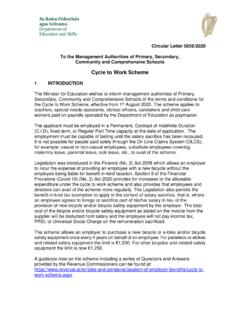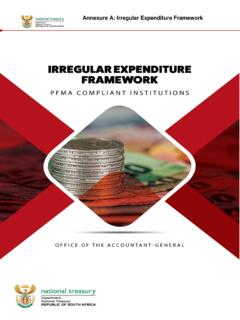Transcription of Typical Costs of Cycling Interventions - GOV.UK
1 Typical Costs of Cycling Interventions Interim analysis of cycle City Ambition schemes Report to the Department for Transport, January 2017. Ian Taylor and Beth Hiblin Project name: Monitoring and evaluation of cycle City Ambition Grants: interim report to Department for Transport compiling Typical Costs of Cycling Interventions Client Reference: Contract SO17265 between DfT & Technopolis/ Transport for Quality of Life/ Sustrans Client: Department for Transport Date: 15 January 2017. Version: 170115 / Final2 to DfT incorporating amendments from local authorities Citation The preferred citation for this report is: Taylor I and Hiblin B (2017) Typical Costs of Cycling Interventions :Interim analysis of cycle City Ambition schemes Client disclaimer Should this report be published by the Department for Transport (DfT), the findings and recommendations remain those of the authors and do not necessarily represent the views of the DfT.
2 While these parties have made every effort to ensure the information in this document is accurate, DfT do not guarantee the accuracy, completeness or usefulness of that information, and cannot accept liability for any loss or damages of any kind resulting from reliance on the information or guidance this document contains. Acknowledgements Thank you to officers from all the cycle City Ambition (CCA) projects who kindly provided the cost breakdowns required and took the time to explain exactly what improvements the funds had provided. Photographs were provided by the project that implemented the scheme under discussion except where otherwise attributed. Cover photograph: Cambridgeshire County Council This report was delivered through the BIS Framework by the Technopolis supplier group. Contact: Transport for Quality of Life Ltd T: 01654 781358.
3 E: W: Typical Costs of Cycling Interventions : Interim analysis of cycle City Ambition schemes 1 | Page Contents Purpose of this document .. 3. Methodology .. 3. Costings: cycle superhighway .. 4. Mixed strategic cycle route .. 6. Resurfaced cycle route .. 8. cycle bridge .. 9. 20 mph zone .. 10. Remodelled major junction .. 11. cycle crossing at major road .. 13. Area-wide workplace cycle facilities .. 14. Area-wide school and college cycle facilities .. 15. Large-scale cycle parking .. 17. Large-scale provision of bicycles .. 18. Comprehensive cycle route signage .. 19. Automatic cycle counters .. 19. Summary and 20. Summary Table: Scheme types and Costs .. 20. Glossary CCA cycle City Ambition grant programme LSTF Local Sustainable Transport Fund grant programme Typical Costs of Cycling Interventions : Interim analysis of cycle City Ambition schemes 2 | Page Purpose of this document This document provides a summary of Typical Costs of Cycling Interventions and the factors that affect them, drawn from expenditure during delivery of Phase 1 of the cycle City Ambition (CCA).
4 Programme. Methodology A list of representative types of outputs to be costed was compiled from a review of CCA bid documentation, progress reports and other monitoring information. Additional information was requested from each CCA project to explain the breakdown of expenditure and the detail of the resulting outputs. Phone conversations with project staff helped tie down remaining specifics regarding the nature, scale and quality of outputs. The CCA programme provided capital-only grants. The examples covered in this document therefore concentrate on outputs from capital expenditure . However, encouraging use of Cycling facilities installed with capital funds is likely to require revenue expenditure . In general, the CCA projects have in the past also undertaken revenue-funded Interventions to encourage Cycling . Where a particular CCA capital intervention is known to be closely linked with ongoing revenue expenditure to maximise its use, that link is mentioned, but figures for revenue expenditure are not included in the costing.
5 Costs quoted are outturn Costs wherever possible. Budgeted Costs have only been used for schemes where final outturn Costs were still awaited and are marked as such. The Costs cited in this document include all capital expenditure on the scheme in question from other sources in addition to the CCA contribution. Typical Costs of Cycling Interventions : Interim analysis of cycle City Ambition schemes 3 | Page Scheme Type: cycle superhighway Definition: An extended cycle route that enables direct, rapid, safe cycle trips largely segregated from traffic along an arterial route a 10km route following an A-road from outer suburbs to a city centre. Typical features: Physically protected segregation from traffic and pedestrians for much of the route, using kerbs, paving level differences or other physical means. Sufficient width to accommodate large flows of cyclists.
6 Cyclist priority at side roads with speed tables to slow cars. Clearway orders to prevent parking in the cycle lane. Cyclist bypasses' to the rear of bus stops forming passenger waiting islands'. Dedicated cycle crossing facilities across major roads, signalised where necessary. A feeling of safety so that unconfident cyclists feel comfortable using the route. Range of unit Costs : cost per km Location and description Local factors affecting cost Greater Manchester's busiest cycle Both sides of the road. Several challenging corridor along Wilmslow/Oxford Road district shopping centres required more to East Didsbury (5km completed, 2km costly solutions. Three bus stop bypasses to follow). 63% fully physically per km, 90% requiring bus stop relocation segregated, 1% lightly segregated', further into the carriageway, with some 28% on-road cycle lane not physically reuse of shelters but most receiving new segregated, 8% shared with shelters.
7 Five crossings upgraded to Toucans pedestrians. per km. brand new Toucan crossings per km. Added cost for night-time working and traffic management on a busy road. Existing highway required repairs in places. Some old signals required cabling re-ducted. Bradford city centre to Leeds city Both sides of the road. Over four bus stop centre continuing to Seacroft in East islands/bypasses per km, 60% requiring Leeds. 23km in total but 32km of relocation and new shelters. One new and physically segregated cycle lane four upgraded road crossings per km counting one-way sections either side (Toucans, Zebras and cycle phases at of the road. 2km through Leeds city existing signals). Night-time working and centre not counted here since it other time restrictions were needed since received only minimal interim the route is a major road.
8 Contaminated measures in advance of CCA Phase 2. materials were unexpectedly unearthed. (Part of route pictured left.) Restricted width in Stanningley Bottom required costly carriageway works to create a shared space road environment. Typical Costs of Cycling Interventions : Interim analysis of cycle City Ambition schemes 4 | Page Cambridge Huntingdon Road (three Costing is for one side of the road, one pictures on ). Not superhighway' in direction only. Three bus stop bypasses per length ( only) but its role in this km with bus shelters renewed and moved smaller city is similar: physically towards carriageway (see middle picture protected segregation for cyclists ). Design and casting of bespoke creating safer and quicker access along Cambridge Kerbs' to edge raised sections of a key radial route. One side, one-way lane, with a chamfered profile that allows only, for inbound peak journeys cyclists (and ambulances) to ride on and off obstructed by traffic congestion.
9 At any point (bottom picture on shows wide uni-directional lane segregated this and segregation by a narrow island by height (80%) or by a narrow kerbed beyond). Inefficient working window of island (20%). Replaced a wide on- to avoid peak traffic. Some road lane. CCA Phase 2 will extend the footway and carriageway replaced to avoid scheme further to the centre. additional disruption and cost later. Greater Manchester Broughton Both sides of road. Lightly segregated' with (budgeted cycleway linking residential areas in striped armadillo' plastic studs and cost ) Broughton to Salford Quays and intermittent lightweight plastic splitter Salford university. Not a super- islands' (two right hand pictures below). highway' in so far as half is marked Segregation broken at bus stops, junctions lanes only, not physically separated and side roads, so of route is on-road from traffic, and the route only totals coloured lanes not physically segregated.
10 , but included to show Costs of a Costs were increased by resurfacing the light segregation' approach. whole road to delay further disruption. Photo credit 2016 Google Key factors influencing cost of delivery: cycle superhighway schemes concentrate on providing the most direct routings possible, which generally are already occupied by major roads. To minimise traffic disruption, construction of physically segregated space for cyclists has to be restricted to off-peak periods or overnight, adding Costs . A higher degree of physical segregation throughout the route, with wider path widths and fewer compromises at side roads and bus stops, raises the cost , but is better for cyclists. Roads with verge and other roadside space, or where the highway itself can be narrowed, allow cheaper route construction (and better outcomes). Tight environments in older centres with buildings close to the roadside require more complex solutions to negotiate obstacles, and may require costly wholesale street redesign to tame cars and make Cycling feel safer.
















